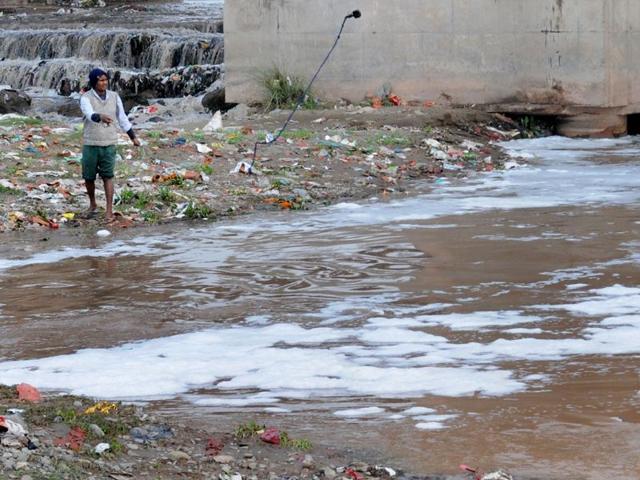Polluted Punjab: Fishing for hope in diseased Ghaggar
If you look at the blackened water of the Ghaggar at several spots, it is hard to believe that this was once known as a ‘darya’, a grand river. It is even harder to believe that people still fish in these waters, though they catch little more than disappointment and disease.
If you look at the blackened water of the Ghaggar at several spots, it is hard to believe that this was once known as a ‘darya’, a grand river. It is even harder to believe that people still fish in these waters, though they catch little more than disappointment and disease.

Basror, Batti, Mardaheri, Jambowali, Heer Ke, Bhagwanpur, Heengra and Sardulgarh are among several villages along the Ghaggar where fishermen no more find any hope.
Against the maximum prescribed limit of 6 BOD (biochemical oxygen demand) level for fish to survive, and less than 4 BOD for human health, the Ghaggar’s BOD level has risen dramatically, ranging from 7 at Mubarakpur near Chandigarh to 24 at Moonak in Sangrur.
The reasons — dumping of waste and untreated industrial effluents — are apparent as the BOD level is 18 downstream near the Dera Bassi industrial belt, and goes up to 22 as the river passes through Rajpura and Patiala. The data is according to the Punjab Pollution Control Board (PPCB), which monitors the water quality at 12 stations so that “wholesomeness of water of the river is maintained”.
“Silver carp and rohu fish are no more available (in the river), but drass carp and common carp traveling from upstream are still caught here,” a senior official of the fisheries department in Patiala told HT.
He said fish market contractors had stopped using fish seed, and were hopeful of a big catch during the monsoon only.
“The river is better for fish between July and September.”
As it flows into Haryana, the Ghaggar stinks beneath the Shambhu Bridge on the inter-state border of Punjab. Here, people can be seen virtually choking the river with flowers, idols and polythene bags, all part of religious rituals, with folded hands. The Ghaggar too needs some prayer.
But farmers somehow find a bright spot. They pump the stinking, polluted water for irrigating vegetables. “Such water carries natural manure,” a farmer said. What this ‘manure’ does to human health is obvious, though.
WHAT PPCB SAYS
PPCB chairman Babu Ram told HT that the menace of pollution would go away as soon as the government installs sewage treatment plants. When asked particularly about the industrial pollution from a paper mill and a distillery between Samana and Patiala, he said action “has always been taken against violators”.
In the absence of any such list of the industrial violators “at hand”, Babu Ram invited complaints: “You tell us. We will take action.”
“I cannot say anything more at this moment,” he said, when asked about environmentalist and board member Balbir Singh Seechewal not being happy with the PPCB going soft in legal actions against the violators.
Seechewal categorically stated, “Lawyers of the pollution board are not effectively pursuing the cases in courts”. His co-worker Pal Singh counted nearly 100 villages surrounding Jalandhar and Phagwara too where people suffer from cancer and serious skin ailments due to the leather industry cluster allegedly throwing the residues into the Kala Sanghian drain. “This 45km drain falls into the Chitti Bein that further flows into the Sutlej, all carrying poison from the leather industry,” Pal Singh said.
Toll and Polls: Health the Victim
Ahead of Samana in Patiala district, at least six villages along the Ghaggar curse the river for diseases ranging from skin allergies to nerve disorders, fading eyesight, disorderly growth of limbs, and constant abdominal pain. Six-year-old Jagdish in Arnetu could barely stand as he struggled with his twisted limbs. Arnetu is one of several villages from where a team of doctors from the Post-Graduate Institute of Medical Education and Research (PGI), Chandigarh, had collected blood samples a few years ago. Harpreet, a Class-5 student, uses heavy glasses as the blackboard is getting blurrier by the day. Mandeep, 13, cannot go to school as he has severe epilepsy. “He can’t even speak. The tongue does not rise,” his mother said. These were some tales as villagers surrounded the HT team, narrating their ailments.
Sarpanch Gurbax Singh said it becomes an issue in every election. Raghbir Singh from nearby Patran, who garnered votes for the Aam Aadmi Party (AAP) in both Sangrur and Patiala, said Ghaggar became an anti-incumbency factor in the recent Lok Sabha polls.
Tomorrow: Voices and accountability




